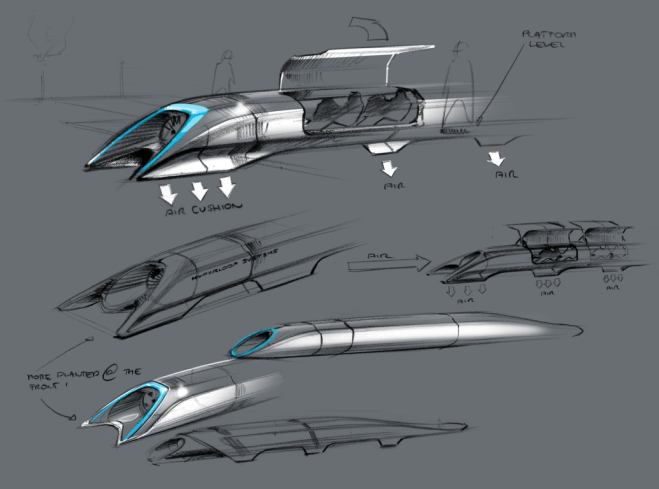Yesterday, Elon Musk, founder of SpaceX and co-founder of Tesla, unveiled plans (pdf) for the “Hyperloop,” which could theoretically transport passengers from San Francisco to Los Angeles in 30 minutes. You know: like the opening credits of Futurama. Seriously. Merchant provides the basics:
The Hyperloop is essentially a giant elevated system that hurls aerodynamic rail-riding capsules through an enclosed steel tube at subsonic speeds.
Musk suggests building the system along Interstate 5, and his finalized schematics say that it could move 840 people per hour—that means 30 pods taking 30 trips per hour, one way. The system would be powered by solar arrays that line the top of the tube. According to the plan, the passenger pods will hold 28 people each. They’ll be fired off at a distance so there’s always 23 miles between the last. Propulsion will be provided by linear accelerators that are placed at various points through the tube—the “rail gun” part of Musk’s famous comment that the Hyperloop was part Concorde jet, part rail gun, and part air hockey table.
Karl Smith explains the physics:
The core design problem that all high speed travel faces is what to do about the air the vehicle runs into. Airplanes deal with this by flying at high altitudes where the air is naturally thinner. This is the basic advantage that planes have going for them, as otherwise there is really no reason to speed a lot of energy and effort leaving the ground, only to come back to the ground later. Here on the ground you can try to get ever more aerodynamic designs as the Shanghi bullet trains do, but there is a limit to how effective this can be.
If you want to go faster and faster eventually you are going to have get a tube in which you can actively play with the air pressure. Most designs, including Musk’s Hyperloop, call for lowering the air pressure inside the tube.
Where’s the toilet? Because I’d be shitting myself cruising at sub-sonic speed in a pod. Plumer questions whether Musk’s proposed costs are really plausible:
Consider some of the major factors for why California’s $68 billion high-speed rail system has gone over budget. In many cases, local communities have demanded extra viaducts and tunnels added to the project that weren’t strictly necessary. Other towns, meanwhile, have insisted they not be bypassed even in cases where it would be cheaper to do so. Would the Hyperloop be immune from these sorts of political pressures and tweaks?
What’s more, California’s high-speed rail project has had to grapple with the high costs of acquiring more than 1,100 parcels of land, often from farmers resistant to sell. The Hyperloop would try to minimize this problem by propping the whole system up on pylons, shrinking its footprint, but it can’t escape the land problem entirely. As Alexis Madrigal points out, Musk’s proposal seems to assume it’s possible to buy up tens of thousands of acres in California for a mere $1 billion. That’s awfully optimistic.
Casey Johnston worries about malfunctions:
The proposal states that it would be hard for a capsule to become stranded within the tube, given that it spends most of its time coasting at a high speed (“no propulsion required for more than 90 percent of the journey). If a capsule was truly rendered immobile by its normal means of travel, however, it would use “small onboard electric motors” to power “deployed wheels” so the cabin could roll itself to safety.
It’s difficult not to imagine a partial loss of sanity among passengers who, thinking they’re in for a half-hour journey, suddenly find themselves taking 10 times as long to get there. Hopefully it wouldn’t be a frequent occurrence. The document makes special note that all capsules would be supplied with enough air to support the passengers even for this failure scenario of a suddenly-normal-length trip.
And Hannah Elliott provides highlights from a conference call with Musk.
